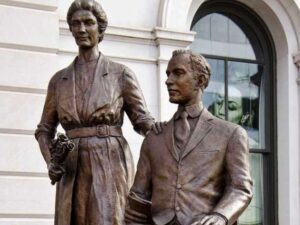» posted on Wednesday, August 19th, 2020 by Linda Lou Burton
Women, And Politics
 August 19, 2020, Linda Lou Burton posting from Little Rock, Arkansas – Iceland, a parliamentary representative democracy at the northern end of the globe, was the first country to have a female president, Vigdís Finnbogadóttir, elected in 1980. It also has the world’s first female and openly gay head of government, Jóhanna Sigurðardóttir, who was elected prime minister in 2009. Iceland has had a woman as either president or prime minister for 20 of the last 36 years. In the 2016 parliamentary election covering 63 seats, 30 women were elected.
August 19, 2020, Linda Lou Burton posting from Little Rock, Arkansas – Iceland, a parliamentary representative democracy at the northern end of the globe, was the first country to have a female president, Vigdís Finnbogadóttir, elected in 1980. It also has the world’s first female and openly gay head of government, Jóhanna Sigurðardóttir, who was elected prime minister in 2009. Iceland has had a woman as either president or prime minister for 20 of the last 36 years. In the 2016 parliamentary election covering 63 seats, 30 women were elected.
New Zealand, a constitutional monarchy with a parliamentary system of government at the southern end of the globe, was the first country in the world in which all the highest offices were occupied by women, between March 2005 and August 2006: the Sovereign Queen Elizabeth II, Governor-General Dame Silvia Cartwright, Prime Minister Helen Clark, Speaker of the House Margaret Wilson, and Chief Justice Dame Sian Elias. Currently Queen Elizabeth II continues as Head of State, Governor-General is Dame Patsy Reddy, Prime Minister is Jacinda Arden and Chief Justice is Dame Helen Winkelmann.
 There has never been a female President or Vice-President in the United States, a federal democratic republic. There has been one female major party presidential nominee in US history: Democrat Hillary Clinton in 2016. She was the first woman nominated for president by a major party, the first woman to participate in a presidential debate, and the first to carry a state in a general election. She won the popular vote in 2016, receiving nearly 66 million votes to Donald Trump’s 63 million.
There has never been a female President or Vice-President in the United States, a federal democratic republic. There has been one female major party presidential nominee in US history: Democrat Hillary Clinton in 2016. She was the first woman nominated for president by a major party, the first woman to participate in a presidential debate, and the first to carry a state in a general election. She won the popular vote in 2016, receiving nearly 66 million votes to Donald Trump’s 63 million.
There have been three female major party vice presidential nominees: Democrat Geraldine Ferraro in 1984, on the ticket with Walter Mondale; Republican Sarah Palin in 2008, on the ticket with John McCain; and Democrat Kamala Harris in 2020, on the ticket with Joe Biden.
Voting
Both Iceland and New Zealand rank in the World List of Voter Participation Top 10 , each averaging about 76% turnout. Others in the TOP 10 are Belgium, Sweden, Denmark, Australia, South Korea, Netherlands, Israel, and Finland. The United States ranks in the World List of Voter Participation Bottom 10, with 56% in the 2016 presidential election. Others in the BOTTOM 10 are Estonia, Luxembourg, Slovenia, Chile, Japan, Latvia, Poland, Mexico, and Switzerland.
August 26, 2020, marks the 100th anniversary of the passage of The Nineteenth Amendment, giving women the right to vote in the United States after 72 years of the largest civil rights movement in the history of the world.
THE WOMAN SUFFRAGE TIMELINE as complied in the LIZ LIBRARY is available for your review; read of the events that have transpired since 1776, when Abigail Adams first spoke up for “the ladies.” http://www.thelizlibrary.org/suffrage/
I offer only a few highlights regarding women’s efforts to be ALLOWED to vote.
1700s
 1776 Abigail Adams writes to her husband, John Adams, asking him to “remember the ladies” in the new code of laws. Adams replies the men will fight the “despotism of the petticoat.”
1776 Abigail Adams writes to her husband, John Adams, asking him to “remember the ladies” in the new code of laws. Adams replies the men will fight the “despotism of the petticoat.”- 1787 U.S. Constitutional Convention places voting qualifications in the hands of the states. Women in all states except New Jersey lose the right to vote.
1800s
- 1848 First Women’s Rights convention in Seneca Falls, New York. Equal suffrage proposed by Elizabeth Cady Stanton. After debate of so radical a notion, it is adopted.
- 1867 Fourteenth Amendment passes Congress, defining citizens as “male;” this is the first use of the word male in the Constitution. Kansas campaign for black and woman suffrage: both lose. Susan B. Anthony forms Equal Rights Association, working for universal suffrage. Suffrage Movement Divides Over Black v. Woman Suffrage.
- 1868 Fourteenth amendment ratified. Fifteenth Amendment passes Congress, giving the vote to black men. Women petition to be included but are turned down. Formation of New England Woman Suffrage Association. In New Jersey, 172 women attempt to vote; their ballots are ignored.
- 1870 Fifteenth Amendment ratified. The Grimke sisters and 42 other women attempt to vote in Massachusetts, their ballots are cast but ignored. Utah territory grants woman suffrage.
- 1878 Woman suffrage amendment first introduced in U.S. Congress.
- 1894 Despite 600,000 signatures, a petition for woman suffrage is ignored in New York.
1900s
- 1910 Washington (state) grants woman suffrage.
- 1911 California grants woman suffrage. In New York City, 3,000 march for suffrage.
- 1912 Teddy Roosevelt’s Progressive Party includes woman suffrage in their platform. Oregon, Arizona, and Kansas grant woman suffrage.
- 1913 Women’s Suffrage parade on the eve of Wilson’s inauguration is attacked by a mob. Alaskan Territory grants suffrage. Illinois grants municipal and presidential but not state suffrage to women.
- 1917 Beginning in January, NWP posts silent “Sentinels of Liberty” at the White House. In June, the arrests begin. Nearly 500 women are arrested, 168 women serve jail time, some are brutalized by their jailers. North Dakota, Indiana, Nebraska, and Michigan grant presidential suffrage; Arkansas grants primary suffrage. New York, South Dakota, and Oklahoma state constitutions grant suffrage.
- 1918 The jailed suffragists released from prison. Appellate court rules all the arrests were illegal. President Wilson declares support for suffrage. Suffrage Amendment passes U.S. House with exactly a two-thirds vote but loses by two votes in the Senate.
- 1919 In January, the NWP lights and guards a “Watchfire for Freedom.” It is maintained until the Suffrage Amendment passes U.S. Senate on June 4. The battle for ratification by at least 36 states begins.
And that battle ENDED in Tennessee on August 18, 1920, 100 years and 1 day ago. The story told by the guide when I toured the Nashville capitol was that young Harry T Burn from Niota gets credit for what happened that fateful day. At least, his mother does. The resolution had passed the Tennessee State Senate, but the vote in the House was close, in fact, on first vote it  did not pass. Harry’s mother, Febb Ensminger Burn, a prominent businesswoman, sent her son a note. After lunch, he changed his vote, then HID from the angry crowds, but that one vote was all it took. Tennessee was the 36th and final state needed for ratification and the 19th Amendment became law August 26, 1920.
did not pass. Harry’s mother, Febb Ensminger Burn, a prominent businesswoman, sent her son a note. After lunch, he changed his vote, then HID from the angry crowds, but that one vote was all it took. Tennessee was the 36th and final state needed for ratification and the 19th Amendment became law August 26, 1920.
Women, and Politics. Interesting.
